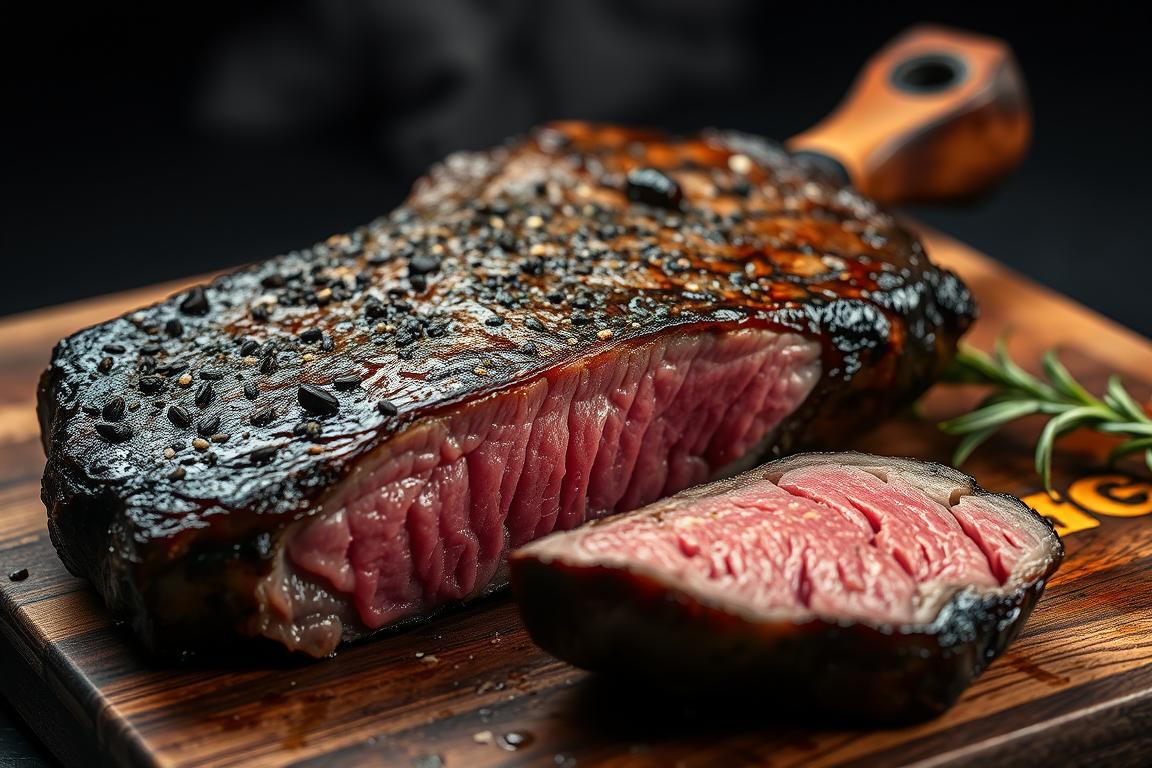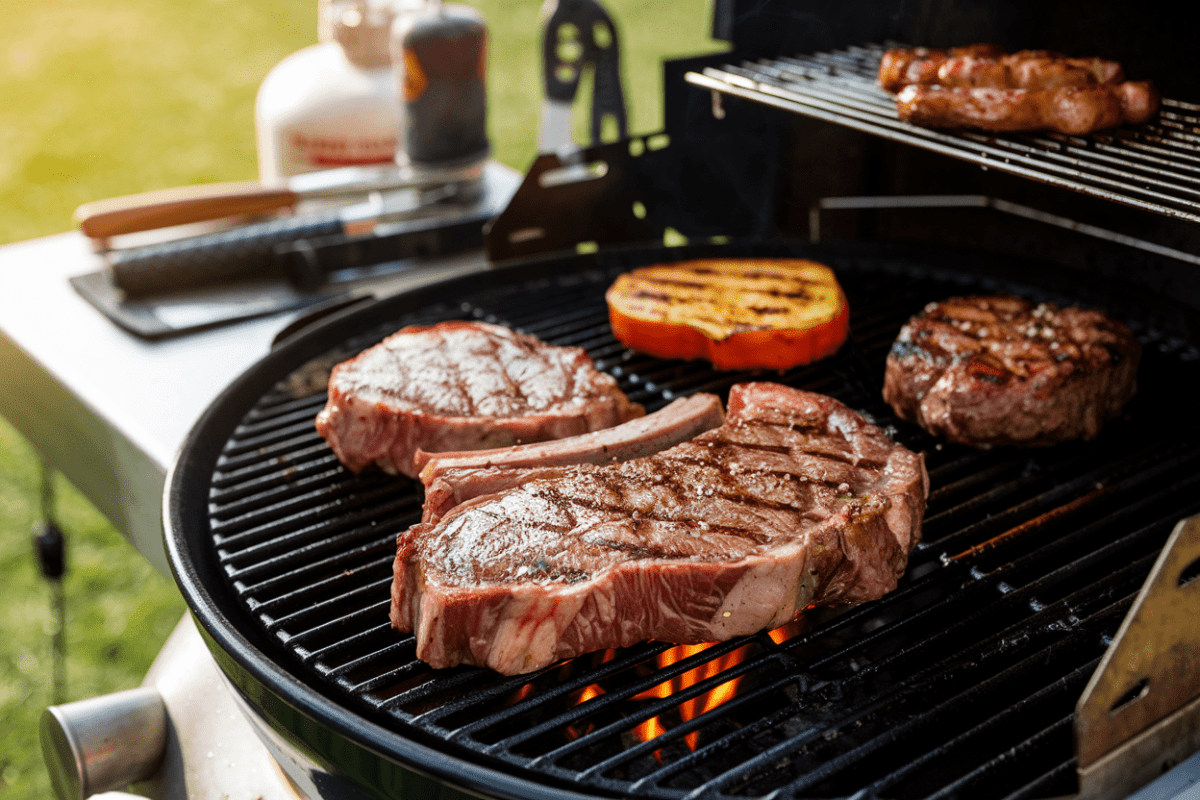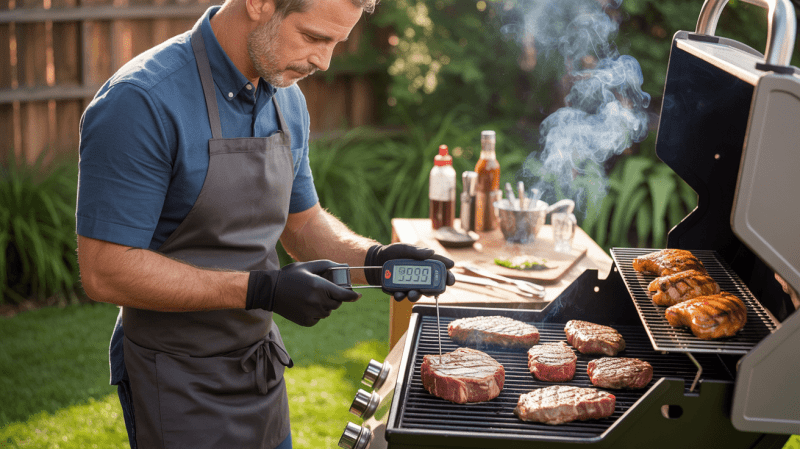Want a top-notch steak taste at home? Our guide on grilling porterhouse steak will boost your outdoor cooking skills. You'll learn how to make the perfect grilled steak.
The porterhouse steak is a true culinary gem. It combines the tender filet mignon with the rich New York strip. This thick cut, 1 1/2 to 2 inches and 1 1/2 to 2 1/2 pounds, is perfect for sharing.

We'll show you a 6-step method for a crispy outside and a juicy inside. Whether you're new to grilling or a pro, our guide will make you a BBQ star. Impress your friends and family with your next grilled masterpiece.
Ready to uncover the secrets of grilling the perfect porterhouse steak? You'll be the highlight of any summer barbecue!
Understanding the Porterhouse Cut: The King of Steaks

The porterhouse steak is a top choice for steak lovers. It offers a luxurious dining experience. This cut has two special sections that make it stand out.
What Makes Porterhouse Unique
The porterhouse steak is unique because of its mix of two premium parts:
- New York strip steak on one side
- Tender filet mignon on the other
It's packed with protein, minerals, and vitamins. It's big, usually 24 to 32 ounces, great for sharing or for those who love meat.
Aging Techniques: Flavor and Texture
There are two main aging methods for porterhouse: dry-aged and wet-aged. Each method changes the steak's taste and texture.
| Aging Method | Characteristics | Price Point |
|---|---|---|
| Dry-Aged Beef | Concentrated flavor, intense marbling, natural tenderization | Higher cost |
| Wet-Aged Beef | Consistent texture, sealed in natural juices | More affordable |
Selecting Your Perfect Cut
Choosing the right porterhouse is important. Look for rich marbling, a deep red color, and even fat distribution. Professional butchers say to pick steaks with even thickness for the best grilling.
Our advice? Ask your local butcher about the steak's origin and aging. Their knowledge can help you find the tastiest one.
Essential Tools and Ingredients for Perfect Grilling
Grilling the perfect Porterhouse steak is more than just skill. You need the right tools and equipment. These can greatly improve your cooking and the taste of your steak.
Here are the essential tools for mastering grilling:
- High-quality meat thermometer for precise temperature control
- Heavy-duty grill tongs
- Cast iron grill grates
- Instant-read digital thermometer
- Sturdy grilling spatula
- Aluminum foil for resting
A good meat thermometer is key for the right doneness. Choose a digital one for quick and accurate readings. It makes controlling the grill temperature easier, preventing overcooking or undercooking.
For a perfect Porterhouse, you'll need these ingredients:
- Prime Porterhouse steak
- Extra virgin olive oil
- Kosher salt
- Fresh ground black pepper
- Fresh garlic
- Dried thyme
- Dried rosemary
- High-quality butter
Being prepared is essential for grilling success. With these tools and ingredients, you're set to make a top-notch Porterhouse steak in your backyard.
How to Grill a Porterhouse Steak
Grilling a perfect porterhouse steak needs precision, skill, and passion. Our guide will show you the key techniques to make a great steak. You'll learn how to turn a simple cut into a top-notch dish.
Preparing the Steak for Grilling
Start by preparing the steak well before grilling. Take the porterhouse out of the fridge 30 minutes early. This step helps the meat cook evenly and stay tender.
- Pat the steak dry with paper towels
- Season generously with kosher salt and black pepper
- Brush lightly with olive oil to enhance grill marks
Temperature Control Techniques
Controlling the grill temperature is an art. For gas grills, heat it to medium-high, around 375-400 degrees Fahrenheit. Charcoal grills need a two-zone setup for direct and indirect heat.
Cooking Time Guidelines
Getting the steak just right takes timing and watching the temperature. Here are some tips for a delicious porterhouse:
- Rare: 4-5 minutes per side, internal temperature 125°F
- Medium-Rare: 5-6 minutes per side, internal temperature 135°F
- Medium: 6-7 minutes per side, internal temperature 145°F
Always check the steak's internal temperature with a meat thermometer. This prevents overcooking. After grilling, let the steak rest for 5-10 minutes. This allows the juices to spread, making the steak juicy and flavorful.
Creating the Perfect Herb and Garlic Marinade
Making a great steak marinade can turn a regular porterhouse steak into a work of art. Our marinade, filled with herbs and garlic, brings out the meat's rich flavors. It also makes the steak tender and juicy.
The secret to a top-notch marinade is finding the right mix of flavors. Our recipe adds aromatic herbs and strong garlic to the steak. This creates a delicious flavor base for grilling.
Essential Marinade Ingredients
- Extra virgin olive oil - helps distribute flavors and prevent sticking
- Fresh minced garlic - adds depth and pungency
- Kosher salt and freshly ground black pepper
- Fresh herbs like thyme and rosemary
Timing is key when marinating a porterhouse steak. We suggest letting it soak in the marinade for 30 minutes to 2 hours. But be careful not to marinate it too long, as it can make the meat tough.
Marinade Preparation Technique
- Combine all ingredients in a non-reactive bowl
- Whisk thoroughly to blend flavors
- Place steak in a sealed container or zip-lock bag
- Pour marinade over the steak, ensuring full coverage
- Refrigerate and turn occasionally for even distribution
If you follow a special diet or prefer simpler flavors, we have other steak seasoning options. They can also make your porterhouse steak taste amazing.
| Marinade Component | Quantity (per steak) | Purpose |
|---|---|---|
| Olive Oil | 1/4 cup | Flavor carrier and moisture retention |
| Minced Garlic | 3-4 cloves | Intense aromatic flavor |
| Fresh Herbs | 2 tablespoons | Aromatic complexity |
| Kosher Salt | 1 teaspoon | Flavor enhancement |
Mastering the Grilling Temperature and Timing
Getting the perfect grilled steak doneness needs precision and patience. The right technique can turn a good steak into an amazing meal. Knowing how to control temperature and cooking time is key for a delicious meal that will wow steak lovers.
Optimal Grill Settings for Your Porterhouse
To cook the perfect porterhouse steak, start by mastering your grill's temperature. Here's what we suggest:
- Preheat your grill to high heat (450-500°F)
- Create two-zone heating for better temperature control
- Use direct heat for searing
- Use indirect heat for more even cooking
Understanding Doneness Levels
Grilled steak doneness depends on internal temperature. Here's a quick guide to help you get it right:
| Doneness | Internal Temperature | Cooking Time |
|---|---|---|
| Rare | 125°F | 4-5 minutes per side |
| Medium Rare | 135°F | 5-6 minutes per side |
| Medium | 145°F | 6-7 minutes per side |
The Importance of Steak Resting Time
The steak resting time is often overlooked by home chefs. After removing the steak from the grill, let it rest for 8-10 minutes. This pause lets the juices spread evenly, making each bite tender and flavorful. The internal temperature will also rise a bit, finishing the cooking.
By following these tips, you'll make your porterhouse steak a dish that will impress anyone.
Signature Seasoning and Butter Combinations
Improving your grilled steak recipes is more than just seasoning. Our unique method turns a simple barbecue steak recipe into a work of art. We use special butter combinations and seasoning techniques.
Making the perfect herb butter needs care and quality ingredients. Our favorite recipe includes:
- Unsalted butter (softened)
- Fresh minced garlic
- Chopped fresh thyme
- Grated parmesan cheese
- Smoked paprika
- Dijon mustard
- Worcestershire sauce
- Freshly ground black pepper
- Dash of hot pepper sauce
To make the compound butter, mix all ingredients until smooth. Pro tip: Roll the butter mixture into a log using plastic wrap and refrigerate for at least an hour to let the flavors meld.
When grilling your porterhouse, try different steak seasoning blends. A classic dry rub has kosher salt, black pepper, garlic powder, and dried herbs. For bolder flavors, add cayenne or smoked paprika to your recipes.
Remember, balance is key. Your seasoning should boost the steak's flavor without overpowering it. Brush the herb butter over the hot steak right after grilling. This lets it melt and create a rich, flavorful crust.
Professional Slicing and Presentation Techniques
Perfecting your porterhouse steak is more than just grilling. The art of slicing and presentation turns a great steak into a masterpiece. Our tips will help you make a dish that looks and tastes amazing.
Cutting Against the Grain: The Secret to Tender Meat
Slicing against the grain is key for tender steak. Cutting perpendicular to the muscle fibers makes each bite soft and easy. Here's how to do it:
- Identify the muscle fiber direction
- Position your knife at a 90-degree angle to these fibers
- Use a sharp knife for clean, precise cuts
- Slice approximately 1/4 to 1/2 inch thick
Dramatic Plating for Maximum Impact
Make your grilled steak sides look amazing with a professional presentation. Remove the meat from both sides of the bone and slice across the grain. Then, place the slices back against the bone. This makes the steak look unsliced and ensures it's tender.
Pro tip: Let your steak rest for 5-10 minutes before slicing to retain those delicious juices!
Add fresh herbs like rosemary or thyme for garnish. Serve with colorful vegetable sides for a memorable meal.
Conclusion
Our journey through porterhouse steak grilling has given you top tips for outdoor grilling. These tips turn a simple meal into a memorable culinary experience. You'll learn how to pick, prepare, and cook this premium cut like a pro.
The reverse sear method is a game-changer for perfect doneness and flavor. Tips like controlling temperature, choosing quality meat, and letting it rest are key. They help you make steaks as good as those in restaurants, right in your backyard.
Grilling is both a science and an art. With practice, you'll get better at managing heat, seasoning, and timing. Each steak is a chance to improve your skills and wow your guests with delicious food.
We urge you to try new things, trust your instincts, and enjoy the journey to becoming a grill master. With patience and passion, you'll soon be grilling steaks that rival those of professional chefs.
FAQ
Q: What is a porterhouse steak?
A: A porterhouse steak is a top-notch beef cut. It has two parts: the tender filet mignon and the flavorful strip steak. These are separated by a T-shaped bone. It's known as the "king of steaks" for its great taste and size.
Q: How thick should a porterhouse steak be for grilling?
A: Choose a steak that's 1.5 to 2 inches thick. This size ensures a perfect sear and a juicy inside. A thicker steak also helps you cook it just right.
Q: What's the best way to season a porterhouse steak?
A: Simple seasoning works best. Use kosher salt and black pepper generously. For more flavor, try a dry rub with herbs and spices. Season the steak at least 40 minutes before grilling.
Q: What internal temperature should I aim for when grilling a porterhouse?
A: The temperature depends on your doneness: - Rare: 125°F (52°C) - Medium Rare: 135°F (57°C) - Medium: 145°F (63°C) - Medium Well: 150°F (66°C) - Well Done: 160°F (71°C) Use a meat thermometer for accurate temperature.
Q: Should I marinate a porterhouse steak?
A: Marinating can add flavor. A simple marinade with olive oil, garlic, and herbs works well. But, keep marinades light to preserve the steak's natural taste.
Q: How long should I let the steak rest after grilling?
A: Let the steak rest for 5-10 minutes. This lets the juices spread, making the steak tender and flavorful. Cover it loosely with foil to keep it warm.
Q: Gas or charcoal grill - which is better for porterhouse?
A: Both grills can make great steaks. Charcoal grills offer smoky flavor and high heat. Gas grills provide consistent heat. The key is to keep the temperature right and not overcook.
Q: How do I know if my steak is done without a meat thermometer?
A: You can use the finger test. Press the steak's center and compare its firmness to your palm. Rare is soft, medium-rare is firmer, and well-done is firm. But, this method is less reliable than a thermometer.



